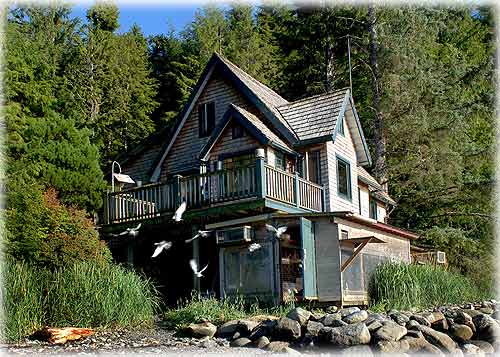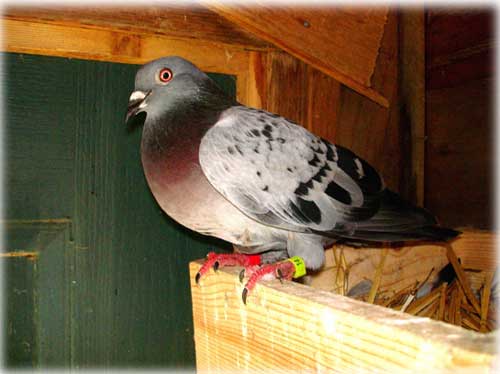 By Sher A. Schwartz September 04, 2007
I raise and train homing pigeons, and the past four years I have been training my birds to come home from various locations around Ketchikan in Southeast Alaska. They've sped back to their north-Ketchikan loft from high peaks like Dude Mountain and from isolated communities, such as Loring, that can only be reached by boat. Most of my birds are racing homing pigeons bred to return from hundreds of miles away. These athletes came to me through the United States Post Office from an established homing pigeon breeder in Beaver Falls, Pennsylvania. I crossed one of the racing homers with a wild bird named Growler, that I had successfully flown, to see how the offspring would compare to the birds bred for homing. Wild pigeons are known to have some homing abilities, but they are generally unable to return from distances much greater than twenty miles.  Photograph courtesy Sher A. Schwartz
The second Sunday in August was so calm and sunny it seemed the perfect opportunity to release the birds from the Prince of Wales Island side of Clarence Strait. My husband agreed to free the pigeons early that morning before he and his brother set their halibut hooks down at Twenty Fathom Bank. The seven birds were carried to the fishing spot aboard the Sea Wolf, my husband's twenty-six foot aluminum boat, in a Belgium wicker release basket. When Bruce held the basket over the deck, the quick release door dropped open and the birds burst out above the shining sea. They rose quickly and began circling over Clarence Strait to orient in the correct direction. Bruce called me later from his cell phone and said, "I'm sure the birds could see home from there." And, indeed, they should have been home within the hour, but events did not unfold as planned. It isn't known exactly how homing pigeons find their way home, but scientists have discovered the birds utilize a variety of methods--just like any good navigator. Genetics influence a bird's ability to navigate in particular conditions and the birds use sight, smell, the magnetic field, and the sun. In addition, an individual bird's personality can play a role in its homing success. US Military records from WWII tell of many brave service birds that returned home, after carrying important messages, "despite being wounded, shot at," and being released from their starting baskets in "near dark conditions." Some birds are so independent and have such a fierce desire for home they ignore the flock and shoot off in the direction they deem correct leaving the flock, still circling, behind. And so it was on that clear day with Growler's offspring Ariadne --the crossbred bird. Bruce recalled seeing one of the birds separate from the flock early on. He said, "the other birds flew toward Prince of Wales Island," which surprised him, because they were flying away from Ketchikan. But he figured, eventually, they'd come back around and head home like they always did. If they had flown directly northeast across Clarence Strait, they would have been home before noon. Three hours later none of the birds had made it home. I scanned the skies and kept walking onto the beach to check the roof, and I repeatedly visited the loft. The pigeon lofts are below the house so I can easily watch my birds come and go. Mid-afternoon I saw, from the living room window, a pigeon come zooming in from Prince of Wales Island. It landed on the platform outside the loft and shot through the trap door. I ran outside, hurried down the stone steps to the beach, and entered the loft. Saucy, flighty, and only half-tame Ariadne stood perched near her mate on a shelf. Five hours had passed and the bird that made it home was a feral-cross --not a purebred homing pigeon! I was surprised.  Theseus escape from King Minos' labyrinth. Photograph courtesy Sher A. Schwartz
Everyone had a theory. In the end two crossbred birds and one racing homer were the birds to make it back. I was stunned that four of the purebred birds--the long distance warriors of the sky--did not make it home. Wynn Smith, founder of Ceremony Dove Release Service in Oregon City, Oregon and the developer of a new breed of pigeon called Release Duvs has spent years considering the genetics of a variety of pigeon breeds including the Columba Livia or the common pigeon. Smith posed a plausible reason for why the feral-cross birds could make it home. The wild pigeons circling above Creek Street and Cape Fox Lodge downtown have been flying for generations over water. Thriving in an archipelago environment, they are born in nests built under pilings. The seawater rises and falls below them with the movement of the tide. In their daily life the Ketchikan birds fly over water to reach all their destinations whether it is to feed on seed or to gather nesting material. Smith suggests it is possible that when faced with Clarence Strait, Ariadne and her offspring tapped into a store of genetic memory enabling them to find the courage to return home; whereas, the racing birds didn't have that resource since their genetic memory did not include repeatedly flying over water. Despite the racing pigeon's deserved reputation as being Olympian of the air, it was the wild cross, Ariadne, that flew straight over the labyrinth expanse of water and islands toward home. She combined the best of both bird types--a familiarity with water crossings and the homing skills and physical endurance of a purebred racing pigeon.
Related Story: Wayward Homing Pigeon Hitchhikes With Fishing Fleet By Heidi Ekstrand - In some cases the Thomas Wolfe quote is true - "you can't go home again." Especially if you can't FIND your way home again! A homing pigeon released in
the Smithers, B.C. area in late June flew northwest and ended
up hitchhiking aboard three commercial fishing boats for a week
near Prince of Wales Island in July instead of flying south to
its home near Vancouver, B.C. - More...
Publish A Letter in SitNews Read Letters/Opinions
|